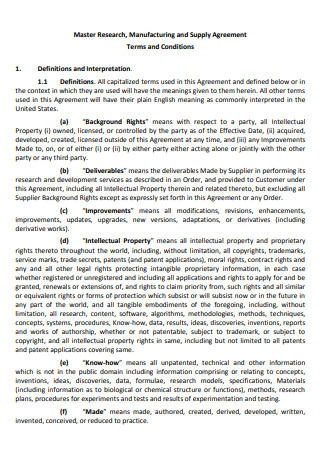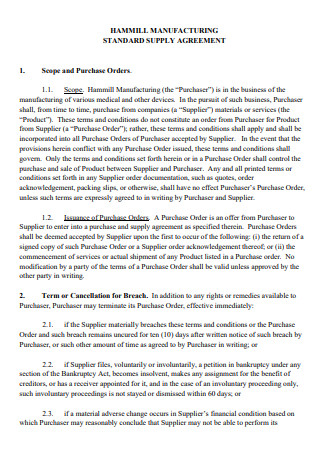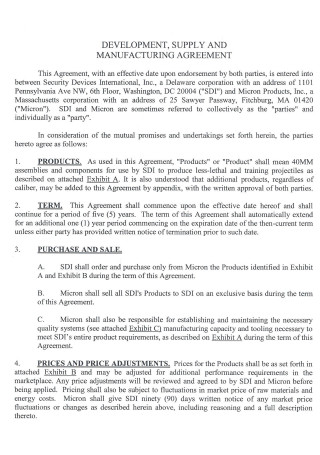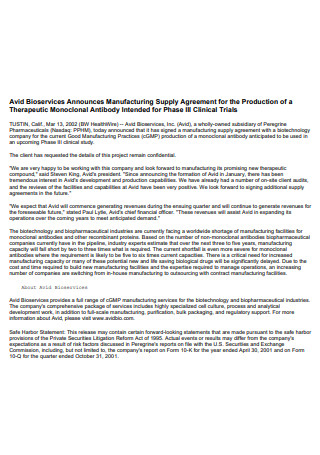4+ Sample Manufacturing and Supply Agreement
-

Master Research Manufacturing and Supply Agreement
download now -

Standard Manufacturing and Supply Agreement
download now -

Manufacturing and Supply Development Agreement
download now -

Manufacturing and Supply Agreement For Production
download now -

Material Manufacturing and Supply Agreement
download now
FREE Manufacturing and Supply Agreement s to Download
4+ Sample Manufacturing and Supply Agreement
What Is a Manufacturing and Supply Agreement?
When Do I Need a Manufacturing and Supply Agreement?
What Are the Most Common Uses?
Why Is There a Need for Manufacturing and Supply Agreement?
Elements of a Manufacturing and Supply Agreement
How to Write a Manufacturing and Supply Agreement
FAQs
How Long Does a Manufacturing and Supply Agreement Last?
Who Are the Parties in a Manufacturing Agreement?
How is a Manufacturing Agreement Different from a Distribution Agreement?
Moreover, the procedures that raw materials go through to become a finished product are referred to as the manufacturing process. The product design and materials specifications from which the product is built are the first steps in the manufacturing process. These materials are subsequently transformed into the desired part through manufacturing methods. All intermediate procedures involved in the manufacture and integration of a product’s components are included in the modern manufacturing report. Fabrication is a phrase used by some businesses, such as semiconductor and steel producers.
What Is a Manufacturing and Supply Agreement?
In a Manufacturing and Supply Agreement, a distributor and the manufacturer or supplier of their products agree on the terms and conditions of their commercial partnership. Say, for example, that your organization developed its own product from scratch. Your business may partner with a manufacturer to develop the product and supply it to your business so that you can distribute the things for sale through your business. Here, you will find all the details pertaining to the cooperation. Any present or future distribution contracts should be considered while calculating the contract’s conditions. If your organization already has distribution agreements in place that state that orders must be filed within a certain length of time, the agreement must allow for this. These conditions will have to be taken into account when negotiating future distribution agreements. This agreement will not just include clauses that guarantee delivery on time. The manufacturing costs, as well as any savings from ordering in bigger numbers, will be listed. This agreement offers the framework for a corporation manufacturing a product to establish pricing and profits. In essence, the terms of this contract are critical to the success of any venture that relies on product distribution.
To further elaborate, when a party wants to buy goods (typically in big quantities) directly from the manufacturer or supplier of the products, this document is utilized. The provider will be held accountable for delivering the requested goods in accordance with the buyer’s specifications. A potential buyer, for example, places an order for 1000 portable blenders. The buyer will specify the blender’s design, color, and voltage in this contract. There are other types of agreement that correspond to this agreement such as supply agreement, supplier agreement contract, supply agreement checklist, and exclusive manufacturing agreement. To discuss more on supply agreement, A supply agreement is a legal document that specifies a seller’s pledge to provide specified products or services to a buyer. It also specifies the fixed price of the offered product or services, with the customer accepting solely to the seller’s terms. Moreover, simple vendor agreement, supply chain agreement, and free service agreement are those agreements that usually satisfies either the seller or buyer.
When Do I Need a Manufacturing and Supply Agreement?
In every business agreement between a manufacturer/supplier and a distributor, a Manufacturing and Supply Agreement should be used. If, for example, your organization creates an entirely new design or product for the market. Finding the proper manufacturer and supplier is just the beginning. You’ll also need to talk about the parameters of the business deal and draft a formal contract that spells out each party’s responsibilities. Diverse clauses would be required by various sectors. In some circumstances, confidential information is a requirement of the contract. If, for example, the product is a brand-new idea that no other company produces, it’s critical that the contract include a language preserving the companies’ confidentiality.
It is also crucial that this product has a provision stating where it can be sold. If you invented the machine that could predict the future and no one else had anything similar, you’d want a clause prohibiting the firm that built it from selling it to a competitor. It’s possible that your business model doesn’t necessitate maintaining the confidentiality or discussing proprietary products. A pharmaceutical distributor, for example, may have contracts with a number of different manufacturers. The Manufacturing and Supply Agreement may not specify that the product can only be sold to your company in this situation. However, it would almost certainly include information on liability and terms to comply with the industry’s numerous regulatory requirements. In summary, if your company sells things that aren’t manufactured in-house, you’ll almost certainly require a contract to ensure that your legal demands are met.
What Are the Most Common Uses?
When a manufacturer and a distributor work together, an agreement such as this is used to describe the responsibilities of each party. These contracts will be needed by a variety of companies. To produce their goods, a start-up will need a Manufacturing and Supply Agreement. In spite of the fact that these agreements cover a wide range of businesses, they all revolve around the creation and sale of a product. Producing a certain amount of stuff for a specified price and within a set time frame is all that the manufacturer is required to do. When a dispute arises, these contracts become vital. This can include how disagreements should be resolved and termination clauses to protect both parties in the event of a partnership dissolution. It is possible to resolve disagreements through a process in most circumstances First, officers from both companies might meet to analyze the business issue and come up with a solution. If the companies are unable to come to an arrangement amicably, the subject may be referred to arbitration or litigated.
Why Is There a Need for Manufacturing and Supply Agreement?
Many businesses, including major organizations with formidable legal departments, have contracts to which they pay insufficient attention. Contracts for manufacture and supply are commonly drawn up, signed, and then filed away. However, there are a variety of consequences to failing to reach an agreement:
1. Less Concrete Manufacturing and Distribution Timeline
The timetable is maybe the most important aspect of the agreement. The distributor will be unable to deliver promised products to its clients if the manufacturer fails to follow the agreed-upon schedule.
2. Unclear Packaging Information
It goes without saying that this agreement has other crucial components. These agreements generally include discussions on packaging and logistics. The expense of mailing a single box to a relative will quickly become apparent.
3. Less Protected Business
When a contract is created and executed, firms frequently scrutinize these clauses. The contract is then filed. Until there’s an issue, that is. The issue – commercial entities failing to meet their contractual duties, the insolvency of one of the parties to the agreement, or consumer legal responsibility difficulties. All of these difficulties can put your company in jeopardy. All of these topics can be discussed within the framework of the agreement. If you’ve written a well-thought-out contract, you should include safeguards to protect your firm and investments in the worst-case situation.
There are almost no safeguards against any of these eventualities without an agreement in place. Your company could be held liable for manufacturer defects, and your partner’s problems could have a cascading effect on yours. It is not enough to get an agreement. It’s critical that your contract is matched to your specific business strategy and transactions. Regularly reviewing your contracts to determine whether the conditions and restrictions best match your current needs is a wise practice.
Elements of a Manufacturing and Supply Agreement
Terms of manufacturing and supply agreements are tailored to the business they are intended to service, with distinct provisions for each. A few popular uses for these contracts are specified to safeguard firms in the event of a dispute, though. A few things to keep in mind when preparing your contract:
How to Write a Manufacturing and Supply Agreement
Anyone who distributes products that were made by another company needs a manufacturing and supply agreement. In your agreement, you can incorporate a variety of clauses to better safeguard your assets and assist you in resolving any future problems. Here are few steps that will help in writing a manufacturing and supply agreement:
1. Agreement to Manufacture
Custom manufacturing services are provided by the Seller during this Agreement’s term, subject to the terms and restrictions herein. Included in these services is the assembling of printed circuit boards (the “Products”) as well as the testing, debugging, and rework of the Products’ subassemblies. Globally, the buyer sells products to other countries.
2. Purchase of Products
It is understood and agreed upon that the Buyer will assume full financial responsibility for all costs related to the acquisition of materials and agreed upon material mark-up associated with materials purchases agreed upon in this purchase agreement on a purchase order or other formal agreement between the parties, the amount of inventory might be specified in specifics.
Ownership. According to the Buyer’s policy, the Seller undertakes to purchase supplies from approved vendors at the best possible price. Aside from that, the Seller commits to purchase materials in a suitable amount to protect lead-time requirements and to take advantage of volume discounts if available.
3. Term and Termination
An effective date shall be set for the duration of this agreement, which shall be 12 full calendar months. It will automatically renew for successive 12-month periods thereafter unless either party delivers 90 days’ written notice prior to the anniversary date of its decision to cancel the agreement. A formal agreement signed by both parties may be used to alter this Agreement at any point in time. Furthermore, each party has the right to terminate this Agreement if the other party fails to perform any material obligation under this Agreement for a period of thirty (30) days after receiving written notice of the violation. The financial responsibilities of both parties will survive any termination of this Agreement, and the Seller will return to the Buyer all tools, equipment, components, drawings, specifications, documentation, and supplies that are owned by Buyer at Buyer’s expense.
4. Purchase Price and Payment Terms
The prices of the products will be specified in the individual purchase orders submitted by the Buyer. If new prices are put into effect as mutually agreed upon throughout the term of this Agreement, such pricing will only apply to purchase orders issued by Buyer after that effective date.
5. Packaging, Shipping, and Delivery
Packaging. All Products must be packaged for transportation in accordance with good business practices, Specifications, government requirements, and other applicable standards in order to safeguard them from loss or damage. Any particular packaging needs should be specified. Furthermore, All shipments of Products under this agreement will be made F.O.B. the Seller’s production plant. Subject to the above, Seller will deliver Products via Seller’s vehicle within 20 miles of such facility at no additional charge, provided that Seller is responsible for and bears all insurance and freight expenses associated with such delivery.
6. Warranties, Remedies, and Limitation of Liability
Seller warrants that any Product delivered to Buyer will be free of defects in materials and workmanship for a period of 12 months (or longer if so warranted by Seller’s suppliers) from the date of delivery (the “Warranty Period”), have been manufactured and assembled in line with Clause, be free of all liens and encumbrances, and conform to its requisition.
The terms and conditions for the manufacturing and selling of the items are outlined in this agreement. This includes, but is not limited to, the description of the goods to be created, their design or specifications, shipment and delivery, the supplier’s warranties, insurance, and the contract’s term and cancellation.
FAQs
How Long Does a Manufacturing and Supply Agreement Last?
The statement refers to how long the agreement will be in effect. You may make a contract that lasts one year or five (5) years.
Who Are the Parties in a Manufacturing Agreement?
As the name suggests, it is an agreement between two parties, namely a supplier and an end customer. Whoever creates the items and supplies them to the Buyer can be a person or a firm called a “supplier.” Orders are placed by a Buyer.
How is a Manufacturing Agreement Different from a Distribution Agreement?
This is also distinct from a Distribution Agreement, in which a supplier of products hands them over to a third party, the distributor, to resell or distribute to additional retail outlets for resale.
This document should be printed and signed by both parties after completion. If one of the parties is an individual, the paper should be signed by the individual. If one of the parties is a corporation, the corporation’s common seal should be affixed to the document, and either two directors or one director and one secretary should sign the paper in the signature column supplied. If one of the parties is not a company, one authorized representative of that organization shall sign the agreement (this includes partnership and sole proprietorship enterprises registered as business names, incorporated trustees, and so on). After both parties have signed the documents and the witnesses have properly attested to them (as the case may be), each party should preserve at least one copy for their records.
